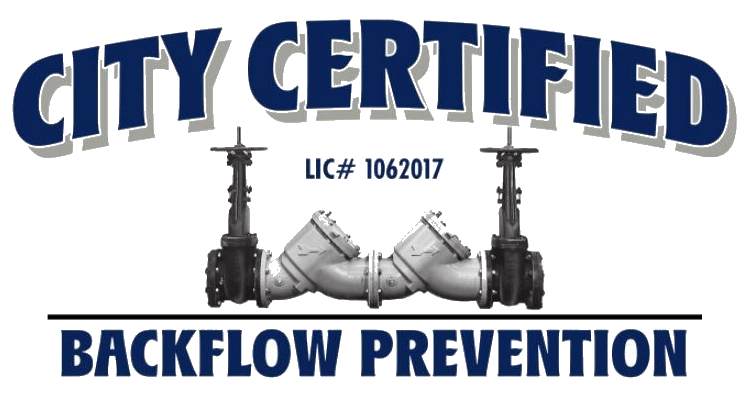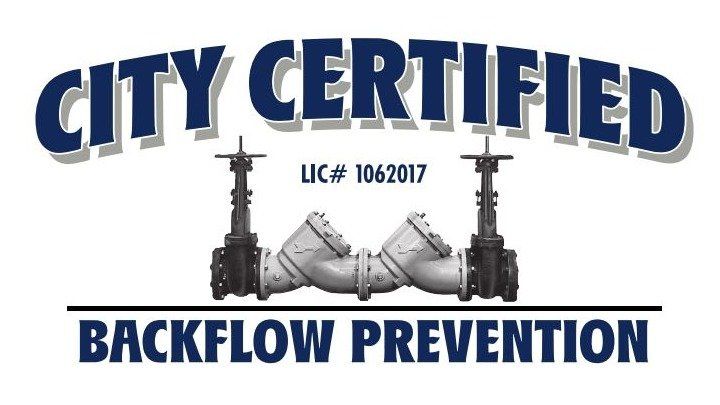FAQ'S
- What is Backflow?
The undesirable reversal of flow of water or mixtures of water and other liquids, gases, or other substances into the distribution pipes of the potable supply of water from any source or sources.
Two types of Backflow
Backsiphonage is a form of backflow due to a reduction in system pressure which causes a negative or sub-atmospheric pressure to exist at a site in the water system; thus siphoning water or substance in the reverse direction of normal flow.
Backpressure is any elevation of pressure in the downstream piping system above the supply system pressure which should cause a reversal of the normal direction of flow.
- What are the 6 most common backflow preventers used in our area?
Atmospheric Vacuum Breaker (AVB), Pressure Vacuum Breaker (PVB), Reduced Pressure (RP), Reduced Pressure Detector Assembly (RPDA), Double Check (DC), and Double Check Detector Assembly (DCDA)
- What is the purpose of a Backflow Preventer?
A backflow preventer is a device that’s installed on your home or business water pipes that allows water to flow in one direction but never in the opposite direction. Its sole job is to prevent drinking water from being contaminated due to backflow.
- Why do backflow preventers have to be tested annually?
Backflow preventers have internal seals, springs, and moving parts that are subject to fouling, wear, or fatigue. Also, backflow preventers and air gaps can be bypassed. Therefore, all backflow preventers must be tested annually at a minimum to ensure that they are functioning properly. A visual check of air gaps is sufficient, but backflow preventers must be tested with properly calibrated gauge equipment.
- What causes a backflow preventer to fail?
There are many reasons why a backflow preventer fails. Some are due to improper placement and installation, regional whether conditions, excessive pressure fluctuation, quality of the water and natural deterioration of the device.
- What is a cross-connection?
A cross-connection is any temporary or permanent connection between a public water system or consumer’s drinking (potable) water system and any source or system containing non potable water or other substances. An example is the piping between a public water system or consumer’s potable water system and an auxiliary water system (underground well) cooling system, heating system or irrigation system.
- Are all backflow testers the same?
In today’s environment we all want the best and sometime it cost no more to hire the best backflow tester or backflow technician. Backflow disasters do happen which could have been avoided. If you looking for the best backflow testing and repair or in need of a specialist that can handle any situation that may arise, City Certified Backflow Prevention is the company you want.
- Why do I have an Internal or Isolation backflow preventer?
If you have a combined service which is a “water service that provides for both domestic and other non-potable uses through the same service connection” you will have or possibly need a backflow preventer at the point of use. It is important to have these backflows preventers tested annually to help prevent cross contamination from a cross-connection occurring.
- Do I need a backflow preventer and if so what type?
Depending on local codes the authority having jurisdiction determines if you need a backflow preventer. They will also choose the type depending on the degree of hazard posed to the potable water system.
- How is backflow testing done?
City Certified Backflow Prevention uses specialized tools to complete this task. Depending on the device and purpose there will be specific criteria that needs to be met in order for a system to be certified.
- Why are backflow preventer above ground?
If a backflow preventer is installed below grade or in a vault it is always possible that the area will fill up with water and the device will be submerged, this may contaminate the water. There is a push for more above-ground enclosures to alleviate this potential hazardous situation.
- What is Backflow?
The undesirable reversal of flow of water or mixtures of water and other liquids, gases, or other substances into the distribution pipes of the potable supply of water from any source or sources.
Two types of Backflow
Backsiphonage is a form of backflow due to a reduction in system pressure which causes a negative or sub-atmospheric pressure to exist at a site in the water system; thus siphoning water or substance in the reverse direction of normal flow.
Backpressure is any elevation of pressure in the downstream piping system above the supply system pressure which should cause a reversal of the normal direction of flow.
- What are the 6 most common backflow preventers used in our area?
Atmospheric Vacuum Breaker (AVB), Pressure Vacuum Breaker (PVB), Reduced Pressure (RP), Reduced Pressure Detector Assembly (RPDA), Double Check (DC), and Double Check Detector Assembly (DCDA)
- What is the purpose of a Backflow Preventer?
A backflow preventer is a device that’s installed on your home or business water pipes that allows water to flow in one direction but never in the opposite direction. Its sole job is to prevent drinking water from being contaminated due to backflow.
- Why do backflow preventers have to be tested annually?
Backflow preventers have internal seals, springs, and moving parts that are subject to fouling, wear, or fatigue. Also, backflow preventers and air gaps can be bypassed. Therefore, all backflow preventers must be tested annually at a minimum to ensure that they are functioning properly. A visual check of air gaps is sufficient, but backflow preventers must be tested with properly calibrated gauge equipment.
- What causes a backflow preventer to fail?
There are many reasons why a backflow preventer fails. Some are due to improper placement and installation, regional whether conditions, excessive pressure fluctuation, quality of the water and natural deterioration of the device.
- What is a cross-connection?
A cross-connection is any temporary or permanent connection between a public water system or consumer’s drinking (potable) water system and any source or system containing non potable water or other substances. An example is the piping between a public water system or consumer’s potable water system and an auxiliary water system (underground well) cooling system, heating system or irrigation system.
- Are all backflow testers the same?
In today’s environment we all want the best and sometime it cost no more to hire the best backflow tester or backflow technician. Backflow disasters do happen which could have been avoided. If you looking for the best backflow testing and repair or in need of a specialist that can handle any situation that may arise, City Certified Backflow Prevention is the company you want.
- Why do I have an Internal or Isolation backflow preventer?
If you have a combined service which is a “water service that provides for both domestic and other non-potable uses through the same service connection” you will have or possibly need a backflow preventer at the point of use. It is important to have these backflows preventers tested annually to help prevent cross contamination from a cross-connection occurring.
- Do I need a backflow preventer and if so what type?
Depending on local codes the authority having jurisdiction determines if you need a backflow preventer. They will also choose the type depending on the degree of hazard posed to the potable water system.
- How is backflow testing done?
City Certified Backflow Prevention uses specialized tools to complete this task. Depending on the device and purpose there will be specific criteria that needs to be met in order for a system to be certified.
- Why are backflow preventer above ground?
If a backflow preventer is installed below grade or in a vault it is always possible that the area will fill up with water and the device will be submerged, this may contaminate the water. There is a push for more above-ground enclosures to alleviate this potential hazardous situation.
QUICK LINKS
@ 2025 Content, including images, displayed on this website is protected by copyright laws. Downloading, republication, retransmission or reproduction of content on this website is strictly prohibited.
Term of Use | Privacy Policy | Accessibility - WEBSITE DESIGNED & DEVELOPED BYA WEB OF DESIGNS



